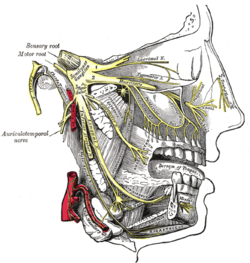Structure and Origin
- The auriculotemporal nerve arises from the posterior division of the mandibular nerve (CN V), which is a branch of the trigeminal nerve (CN V).
- It arises by two roots that circle around either side of the middle meningeal artery before uniting to form a single nerve.
- The nerve passes deep to the neck of the mandible, between it and the sphenomandibular ligament, and then courses deep to the lateral pterygoid muscle.
Course
- The roots of the auriculotemporal nerve circle around both sides of the middle meningeal artery before uniting.
- The nerve issues parotid branches and turns superiorly, posterior to its head, and moves anteriorly.
- It gives off anterior branches to the auricle and crosses over the root of the zygomatic process of the temporal bone.
Parasympathetic Component
- Post-ganglionic parasympathetic secretomotor nerve fibers from the otic ganglion join and hitch-hike along the auriculotemporal nerve.
- These fibers leave the nerve as it passes across the anteromedial surface of the parotid gland.
- The parasympathetic fibers enter and innervate the parotid gland.
- The otic ganglion is involved in the parasympathetic component of the auriculotemporal nerve.
Distribution
- The auriculotemporal nerve provides sensory innervation to the auricle, external acoustic meatus, outer side of the tympanic membrane, and the skin in the temporal region.
- It carries a few articular branches that innervate the temporomandibular joint.
- The nerve also has superficial temporal branches that innervate the superficial temporal region.
- The distribution of the auriculotemporal nerve includes the auricle, external acoustic meatus, tympanic membrane, temporal skin, and temporomandibular joint.
Overall Function
- The auriculotemporal nerve is involved in the sensory innervation of various structures in the head and neck region.
- It plays a role in the innervation of the parotid gland through its parasympathetic component.
The auriculotemporal nerve is a sensory branch of the mandibular nerve (CN V3) that runs with the superficial temporal artery and vein, and provides sensory innervation to parts of the external ear, scalp, and temporomandibular joint. The nerve also conveys post-ganglionic parasympathetic fibres from the otic ganglion to the parotid gland.
| Auriculotemporal nerve | |
|---|---|
 Sympathetic connections of the otic and superior cervical ganglia. (Auriculotemporal labeled at top right.) | |
 | |
| Details | |
| From | mandibular nerve |
| Innervates | temple |
| Identifiers | |
| Latin | Nervus auriculotemporalis |
| TA98 | A14.2.01.074 |
| TA2 | 6261 |
| FMA | 53000 |
| Anatomical terms of neuroanatomy | |
auriculotemporal nerve (plural auriculotemporal nerves)